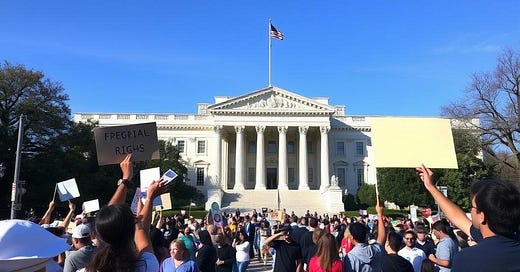The 28th Amendment: Ratified But Not Actionable
Why the Equal Rights Amendment’s Future Is Stuck in Limbo—and How It Could Be the Key to Fixing Black Maternal Health
So the Equal Rights Amendment is officially ratified, right? Not so fast. Turns out, adding a new amendment to the United States Constitution is more complicated than it seems—and this time, the stakes are life and death for Black women in America.
What’s Going On with the ERA?
Here’s the Policy Tea: The Equal Rights Amendment (ERA) was created to guarantee equality under the law, regardless of gender. Which in 2025 makes sense right? Yet journey to ratification has been anything but.
After Congress passed the ERA in 1972, it needed 38 states to ratify it before a 1982 deadline. By the deadline, only 35 states had signed on . But in recent years, Nevada (2017), Illinois (2018), and Virginia (2020) stepped up, hitting the magic number. Then-President Biden declared the ERA as the 28th Amendment within last 9-5 hours left of his administration on January 17th, 2025. Victory, right?
I wish. The National Archives—the folks responsible for officially publishing amendments in the Constitution—said good one, but nope. Why? Because of the expired deadline. According to the archivist, Congress or the courts still need to clear the legal haze before the ERA can officially be added.
Black Women Deserve Better, and the ERA Could Deliver
Here’s where things get real: if the ERA becomes official, it could change the game for Black maternal health in the U.S.
Around the world, maternal mortality rates fell 44 percent 1990-2015, but in the US, maternal mortality jumped 16.7 percent, making the United States the only developed country with a rising maternal mortality rate. This isn’t just a health crisis; it’s a health justice crisis rooted in systemic inequities—bias in treatment, lack of access to quality care, and the absence of accountability.
Black women are 2 to 3x more likely to die during childbirth than white women.
-Centers for Disease Control and Prevention.
An official Equal Rights Amendment would make it harder for these inequities to hide. It would:
Force accountability: Healthcare providers and institutions could be held to constitutional standards of equality.
Push for better policies: Governments would have to prioritize equitable access to healthcare.
Give legal power to advocacy: The ERA would give advocates a constitutional foundation to demand better protections and resources.
Imagine a future where addressing racial disparities in maternal health isn’t just a good idea—it’s a legal requirement. That’s the potential of the ERA.
So …What’s Next?
Here’s the frustrating part: it’s still a waiting game. Opponents argue the ERA’s expired deadline invalidates the recent ratifications. Supporters are pushing Congress and the courts to settle the issue once and for all .
Meanwhile, the ERA sits in a weird limbo—technically ratified but not officially activated. It’s like putting the key in the ignition but not turning it.
Your Advocacy Dose
This isn’t just about politics or procedure; it’s about lives. Equality shouldn’t be this hard to lock in.
If you care about making equality real for everyone—and using the law to back it up—subscribe and stay plugged into The Advocacy Dose. We’ll keep you updated on the ERA’s journey and show you how to take action in the fight for justice and equity.






